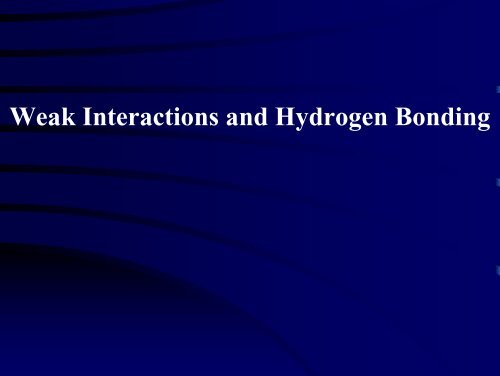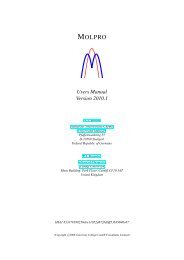Weak Interactions and Hydrogen Bonding
Weak Interactions and Hydrogen Bonding
Weak Interactions and Hydrogen Bonding
You also want an ePaper? Increase the reach of your titles
YUMPU automatically turns print PDFs into web optimized ePapers that Google loves.
<strong>Weak</strong> <strong>Interactions</strong> <strong>and</strong> <strong>Hydrogen</strong> <strong>Bonding</strong>
The <strong>Hydrogen</strong> Bond<br />
- A Flexible Tool in Supramolecular Chemistry<br />
(Ch. 2.6-7, p. 92 – 102, Concepts <strong>and</strong> Models of Inorganic<br />
Chemistry : Douglas et al, 3rd Edition, Wiley, 1994 )
Latimer <strong>and</strong> Rodebush in 1920 introduced the term<br />
“<strong>Hydrogen</strong> bond” to describe the nature of<br />
association in the liquid state of water, hydrogen<br />
fluoride, & so on.<br />
(1) D:H:A (responsible for m.p. & b.p.)<br />
(2) D-H (O, F, N) … A<br />
~ 4 - 50 kJ/mol for neutral molecules<br />
(~ 100 - 400 kJ/mol for typical covalent bonds)
Evidence for <strong>Hydrogen</strong> <strong>Bonding</strong>
Intermolecular hydrogen bonding in pure substances<br />
increases the heat of vaporization in two ways :<br />
(1) By increasing the attraction between molecules.<br />
(b.p.)<br />
(2) By restricting rotation of the molecules in the<br />
liquid. (∆S
Consequences of <strong>Hydrogen</strong> <strong>Bonding</strong><br />
Also apply for some nonaqueous solutions.
<strong>Hydrogen</strong> <strong>Bonding</strong> Involving Charged Species<br />
Anion-Molecule <strong>Interactions</strong><br />
(1) NaF (s) + (HF) x(g) ↔ NaHF 2(s) ∆H = -69 kJ/mol<br />
(LiF : -43kJ/mol, KF : -88kJ/mol, RbF : -93kJ/mol,<br />
CsF : -98kJ/mol, TMAF : -155kJ/mol)
KHF 2 : K + (FHF) - ; F … F in (FHF) - = 225 pm<br />
(r F - = 119 pm)<br />
mp : KF – 846 °C, KHF 2 –239 °C<br />
(Production of F 2 by electrolysis of fused KF-HF<br />
baths at LT)
Summary :<br />
1. Loss in lattice energy (old & new)<br />
2. Gain in hydrogn-bonding energy
Strong acid of liquid HF, but weak acid in water,<br />
indicating that ∆ solv of the fluoride ion is much<br />
more negative in HF than in water. HCl & HBr<br />
are strong acids in water.
(2) KOH (s) + H 2 O (g) → KOH . H 2 O (s)<br />
∆H = -84 kJ/mol<br />
(especially where it is also desirable simultaneously<br />
to remove CO 2 )
Cation-Molecule <strong>Interactions</strong><br />
(3) Solids may contain the hydrated hydrogen ion<br />
in species varying from H 3 O + up to H 9 O 4+ .<br />
HBr (mp = -86 °C)<br />
HBr . H 2 O (mp = -4 °C), HBr . 4H 2 O (mp = -56.8 °C)<br />
Same for HI (x = 4), but not for HCl (x < 4).
4 x C (4-coordinate)<br />
6 x N (6-coordinate)<br />
Clathrated benzene<br />
[Co(NCS) 4 ] 2- , [Hg(SCN) 4 ] 2-<br />
[Pd(NCS) 4 ] 2- at RT (solid)<br />
[Pd(SCN) 4 ] 2- at HT (solid) or in solution
(S 2 )<br />
(S 1 )
2.7.4 van der Waals Radii<br />
The internuclear separation between nonbonded<br />
atoms that are in contact is determined by their<br />
van der Waals Radii (For both atoms are identical<br />
– then, the van der Waals Radius is simply half<br />
of the nonbonding separation).
If two atoms are found to be closer than the sum<br />
of their van der Waals Radii in a crystal, a<br />
hydrogen bond between them usually supplies the<br />
explanation (shortening distance : O … O / O … N ~<br />
30 pm).
M = Au, Ag
Stavropoulos et al, JACS, 1997, 119, 2942.
Cu…Cu intra = 3.52(5) Å<br />
Cu…Cu inter = 2.905(3) Å
Ag(1)…Ag(3) = 3.835(5)Å<br />
Ag…Ag inter = 3.227(2) Å
Linear-Chain Pt Materials<br />
(I) Interesting structural properties<br />
(II) Intriguing spectroscopic properties<br />
(III) Conductivity
Electrical Conductivity :<br />
1. Free-electron model versus energy-b<strong>and</strong> model<br />
2. Electrical conductivities:<br />
Metals – σ > 10 3 S/cm (or Ω -1 /cm)<br />
Semiconductor (0.7-1 eV)<br />
Insulators - σ < 10 -9 S/cm ( > 6 eV)
One-Dimensional Conductors :<br />
(1) Salts of partially oxidized tetracyanoplatinate<br />
complexes<br />
Anion-deficient salts :<br />
(cation) 2 [Pt(CN) 4 ]X x. yH 2 O (x < 0.4)<br />
- KCP(X), K 2 [Pt(CN) 4 ]X 0.3. 3H 2 O, X=Cl, Br
(2) Salts of partially reduced tetracyanoplatinate<br />
complexes<br />
Cation-deficient salts :<br />
(cation) x [Pt(CN) 4 ] . yH 2 O (1 < x < 2)<br />
Rb 2 [Pt(CN) 4 ] . (FHF) 0.4 – metallic luster & large<br />
electrical conductivity (2,300 S/cm)
[Pt(CN) 4 ] z- : Pt-Pt = 2.86 – 2.97 Å<br />
(2.775 Å in metallic Pt)<br />
metallic behavior : Pt considered as equivalents<br />
<strong>and</strong> electron delocalization along a delocalized<br />
partially filled electron-energy b<strong>and</strong> comprised<br />
of overlapped platinum 5d z2 orbitals.<br />
(10 5 for parallel to the Pt-Pt chain compare to<br />
the perpendicular one).
(i) Intramolecular interactions (i.e., S … S)<br />
(ii) Strained chelates<br />
NH<br />
NH
The most favorable cases for trigonal prismatic<br />
coordination are d 0 , d 1 , d 5 , d 10 , & high-spin d 7 .<br />
These are cases that do not involve strong preference<br />
for octahedral coordination because of lig<strong>and</strong>field<br />
stabilization (LFSE).












![Hetero [6+3] Cycloaddition of Fulvenes with N-Alkylidene Glycine ...](https://img.yumpu.com/35423358/1/190x245/hetero-6-3-cycloaddition-of-fulvenes-with-n-alkylidene-glycine-.jpg?quality=85)




